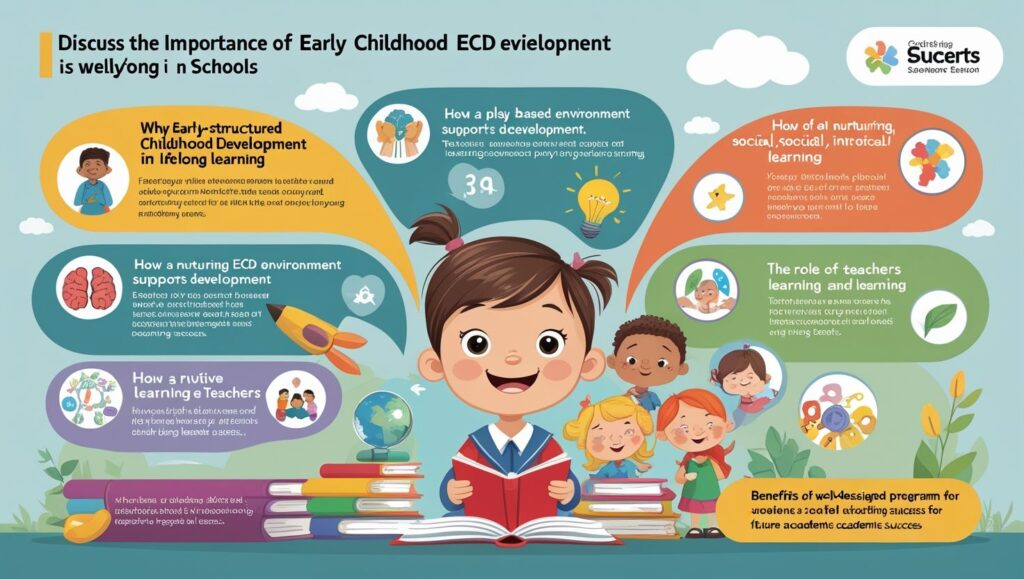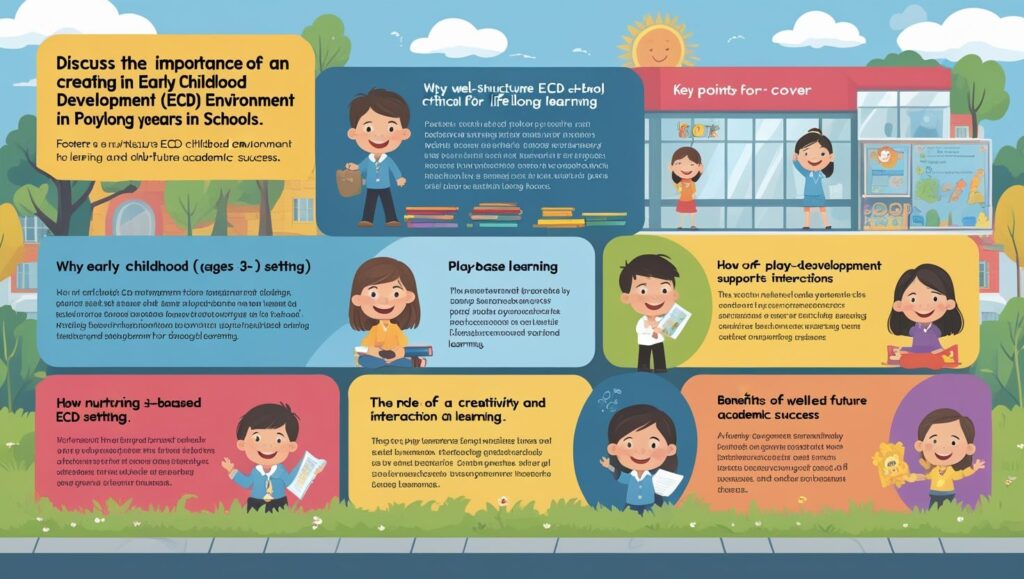Introduction
The Importance of (ECD) Environment in Schools, In recent years, there has been a growing global emphasis on the importance of environmental education, particularly within school settings. Early Childhood Development (ECD) is a foundational stage in a child’s life, where attitudes, behaviors, and values are shaped. Integrating environmental consciousness into ECD programs is essential, as it not only fosters a sense of responsibility toward the planet but also equips young learners with the knowledge and skills needed to address future ecological challenges.
This article explores the significance of establishing an environmentally aware ECD environment in schools, examines effective strategies for implementation, and highlights the long-term benefits for children, communities, and the planet.
The Importance of Environmental Consciousness in ECD
Early childhood is a critical period for cognitive, emotional, and social development. During these formative years, children are highly receptive to learning and internalizing values that shape their worldview. Introducing environmental education at this stage helps instill principles of sustainability, conservation, and ecological stewardship.
Key Reasons for Environmental Education in ECD:
- Foundation for Lifelong Values – Early exposure to environmental concepts helps children develop a deep-rooted respect for nature, encouraging sustainable habits that persist into adulthood.
- Enhanced Cognitive and Emotional Development – Interaction with nature stimulates curiosity, creativity, and problem-solving skills while fostering empathy for living organisms.
- Connection to the Natural World – Many modern children have limited exposure to nature, leading to “nature deficit disorder.” Environmental education bridges this gap, promoting physical and mental well-being.
- Preparation for Future Challenges – As climate change and ecological degradation become pressing issues, educating children early ensures they grow into informed, proactive citizens.

Strategies for Creating an Environmentally Conscious ECD Environment
To effectively integrate environmental awareness into early childhood education, schools should adopt a multi-faceted approach that combines experiential learning, sustainable practices, and community involvement.
1. Nature-Based Learning
- Outdoor Exploration: Regular nature walks, outdoor play, and gardening activities allow children to engage directly with their environment.
- Hands-On Experiences: Planting trees, observing wildlife, and exploring ecosystems help children understand biodiversity and ecological balance.
- Sensory Learning: Nature stimulates all five senses, enhancing cognitive and motor development while fostering a love for the outdoors.
2. Eco-Friendly School Practices
- Waste Reduction & Recycling: Schools should implement recycling programs, composting, and reusable materials to teach children about waste management.
- Energy & Water Conservation: Simple practices like turning off lights, using rainwater harvesting, and promoting energy-efficient appliances instill sustainable habits.
- Green School Infrastructure: Incorporating solar panels, green roofs, and natural lighting can make schools more eco-friendly while serving as educational tools.
3. Inquiry-Based and Experiential Learning
- Child-Led Exploration: Encouraging children to ask questions about nature and guiding them to discover answers fosters critical thinking.
- Problem-Solving Activities: Projects like building bird feeders or creating mini compost bins teach practical environmental solutions.
- Science Integration: Simple experiments (e.g., observing plant growth, testing water quality) make environmental science engaging.
4. Storytelling and Creative Arts
- Eco-Themed Stories: Books and narratives about nature, conservation, and wildlife help children connect emotionally with environmental themes.
- Art & Music: Drawing, painting, and songs about the Earth reinforce learning in a fun, memorable way.
- Role-Playing & Dramatization: Activities like pretending to be animals or environmental heroes deepen understanding through imagination.
5. Community and Family Involvement
- Local Partnerships: Collaborating with environmental organizations, parks, and wildlife centers provides real-world learning opportunities.
- Parent Engagement: Workshops, family nature days, and take-home eco-projects extend learning beyond the classroom.
- Community Projects: Tree-planting drives, neighborhood clean-ups, and eco-fairs encourage collective environmental action.

Benefits of an Environmentally Conscious ECD Environment
1. Holistic Child Development
- Physical Health: Outdoor play improves motor skills, reduces obesity, and boosts immunity.
- Emotional Well-being: Nature reduces stress and enhances mood, contributing to mental health.
- Social Skills: Collaborative environmental projects teach teamwork, communication, and leadership.
2. Academic Enhancement
- Studies show that nature-based learning improves concentration, creativity, and academic performance in subjects like science and math.
3. Long-Term Environmental Stewardship
- Children who grow up with environmental education are more likely to adopt sustainable lifestyles and advocate for ecological policies.
4. Positive Societal Impact
- Environmentally conscious children influence their families and communities, leading to broader cultural shifts toward sustainability.
Conclusion
Establishing an environmentally conscious ECD environment is not just an educational enhancement—it is a necessity for raising a generation that values and protects the planet. Through nature-based learning, sustainable school practices, creative teaching methods, and community engagement, educators can nurture environmentally literate, responsible, and proactive individuals.
Investing in early environmental education is an investment in the future—ensuring that children grow up with the knowledge, skills, and passion needed to address global ecological challenges and create a more sustainable world. Schools play a pivotal role in this mission, shaping not only young minds but also the future of our planet.

Can you be more specific about the content of your article? After reading it, I still have some doubts. Hope you can help me.
zqektd
90mqxl
I have not checked in here for some time as I thought it was getting boring, but the last several posts are great quality so I guess I will add you back to my daily bloglist. You deserve it my friend 🙂
875aql
Nikmati Permainan Slot Gacor di sigmaslot dengan RTP Tinggi dan Jackpot Menggoda
Looking for the best alarm clock radio with CD player and modern features? This HD tabletop radio combines vintage charm with today’s technology. Features include a CD player, AM/FM radio, dual alarm settings, and a USB port for device charging. Perfect for bedside tables or desktops, the sleek design doesn’t sacrifice performance. Whether you’re waking up to your favorite radio station, a beloved CD, or a gentle buzzer, this unit is your all-in-one morning companion. The CD clock radio is back—and better than ever.
This all-in-one clock radio CD player is more than just an alarm—it’s a full media hub. Along with a traditional CD player, it features AM/FM radio, Bluetooth connectivity, and a wireless remote control. Dual alarms make it easy to set different wake times, while the large LED display ensures easy readability. With rich stereo sound and multiple playback options, it’s one of the best clock radios with CD player and Bluetooth functionality. Great for music lovers who value versatility in a radio alarm clock CD player setup.
Este site é realmente fabuloso. Sempre que consigo acessar eu encontro novidades Você também pode acessar o nosso site e descobrir detalhes! Conteúdo exclusivo. Venha saber mais agora! 🙂
Can you be more specific about the content of your article? After reading it, I still have some doubts. Hope you can help me.
Your article helped me a lot, is there any more related content? Thanks!
Some truly howling work on behalf of the owner of this internet site, perfectly great articles.
Thank you for your sharing. I am worried that I lack creative ideas. It is your article that makes me full of hope. Thank you. But, I have a question, can you help me?
Pretty! This was a really wonderful post. Thank you for your provided information.
Thanks for the sensible critique. Me and my neighbor were just preparing to do a little research on this. We got a grab a book from our area library but I think I learned more from this post. I am very glad to see such fantastic info being shared freely out there.
It’s actually a great and helpful piece of info. I’m glad that you just shared this useful information with us. Please keep us informed like this. Thank you for sharing.
After examine a few of the blog posts in your website now, and I truly like your approach of blogging. I bookmarked it to my bookmark web site record and can be checking back soon. Pls take a look at my website online as effectively and let me know what you think.
Youre so cool! I dont suppose Ive read anything like this before. So nice to seek out any individual with some unique ideas on this subject. realy thanks for beginning this up. this website is something that’s wanted on the net, someone with a little originality. helpful job for bringing something new to the web!
Some times its a pain in the ass to read what blog owners wrote but this internet site is rattling user genial! .
This actually answered my drawback, thank you!
After I initially commented I clicked the -Notify me when new feedback are added- checkbox and now every time a comment is added I get 4 emails with the same comment. Is there any method you possibly can take away me from that service? Thanks!
I envy your piece of work, appreciate it for all the informative blog posts.
Reading your article has greatly helped me, and I agree with you. But I still have some questions. Can you help me? I will pay attention to your answer. thank you.
Oh my goodness! an incredible article dude. Thank you Nonetheless I’m experiencing difficulty with ur rss . Don’t know why Unable to subscribe to it. Is there anybody getting equivalent rss problem? Anyone who knows kindly respond. Thnkx